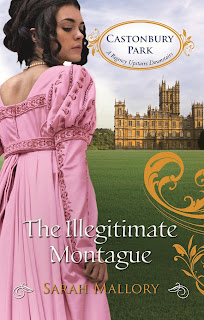Welcome!
I am so pleased to be part of the Castonbury Park Series, and for my characters I chose to write more about "downstairs" characters - in fact, my main characters are outside the big house altogether!
This book is
number 5 in the series and I wanted to tell the housekeeper's
story. Hannah Stratton is a much loved figure at Castonbury, she has seen the
children grow up and has a son of her own, Adam, whom she has not seen for ten years. She has never spoken about his father, or
told anyone her history, but in this book it is necessary for her to put the
record straight.
The Illegitimate
Montague features Hannah's son, Adam. He has been away from Castonbury for many
years, making a name for himself first as a captain in Nelson's navy, then in
the north of England, where he becomes a mill owner. As a manufacturer of
cloth, he has plenty in common with Amber Hall, the clothier who owns a
warehouse and shop in Castonbury, and I could see them both working well
together in the future , making the most of the opportunities that would
present themselves in the forthcoming Victorian era –
once they have overcome all the obstacles that I throw in their way, of course!
Without
giving too much away, I can tell you that there is a disastrous fire at one
point in the story, and this started me thinking about insurance. We take if
for granted now, but not so in the Regency. However, the idea of fire insurance
goes back to the days of the great fire of London in 1666.
He is credited with setting up the first of several fire insurance companies formed around that time, others included the Friendly Society (1683), Hand-in-Hand (1696) Sun Fire Office (1710) and Royal Exchange Assurance (1720).
To identify that a property was covered by fire insurance, attached to the building, at a height easily seen from the street but out of reach of thieves, was a sign or emblem called a fire mark which was issued by the company. Each company had its own distinctive design which made identification of the property easier for their fire fighters and the company representatives. Designs included, for Sun Fire Office: a large sun with a face (like the image below); the Royal Exchange Assurance: their building; and Phoenix: obviously Phoenix rising from the ashes.
 |
|
credit: Pauline Eccles [CC-BY-SA-2.0
(http://creativecommons.org/licenses/by-sa/2.0)], via Wikimedia Commons |
Sarah Mallory.


7 comments:
lookint forward to reading it, Sarah!
I had no idea that the origins of some present-day insurers had such fascinating origins. Now I'm wondering what would happen if you had a fire, the fire engine turned up, and you didn't have the right sign? Fascinating Sarah, thank you for sharing this.
Thanks, Annie, hope you enjoy it. Marguerite, I think I read somewhere that if you didn't have the right insurance, they would go away again and leave you to burn!
Thanks for this very interesting post. Did those images, like the sun, go to the rest of Europe as well? It does look familiair.
This sounds so good! Your research is fascinating.
I am reminded of the recent terrible fire in that clothing factory in Bangladesh. Such a tragedy and so many lives lost. So sad.
Congrats on your book's release!
Aurien - I am sure many companies used similar symbols, especially the Phoenix Fire company's image of a phoenix rising from the ashes - so appropriate.
Thanks for your comment, Cheryl.It is a pity that tragedies still occur, when we know so much more now about how to make buildings safe.
Thanks for dropping by, everyone.
Thanks for blog :)
Post a Comment